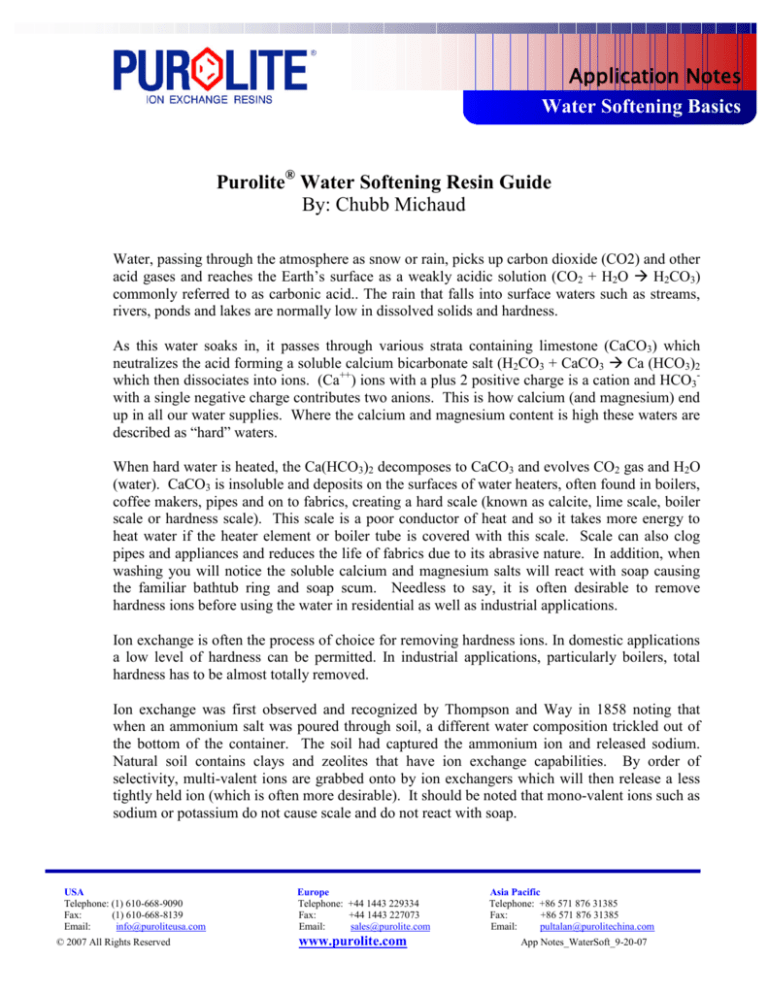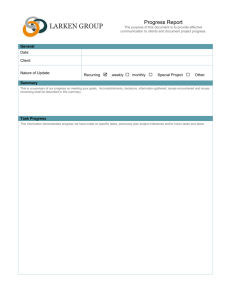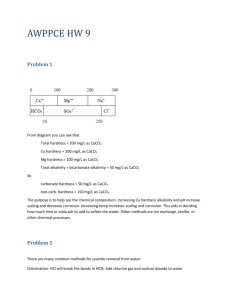
Application Notes
Water Softening Basics
Purolite® Water Softening Resin Guide
By: Chubb Michaud
Water, passing through the atmosphere as snow or rain, picks up carbon dioxide (CO2) and other
acid gases and reaches the Earth’s surface as a weakly acidic solution (CO2 + H2O H2CO3)
commonly referred to as carbonic acid.. The rain that falls into surface waters such as streams,
rivers, ponds and lakes are normally low in dissolved solids and hardness.
As this water soaks in, it passes through various strata containing limestone (CaCO3) which
neutralizes the acid forming a soluble calcium bicarbonate salt (H2CO3 + CaCO3 Ca (HCO3)2
which then dissociates into ions. (Ca++) ions with a plus 2 positive charge is a cation and HCO3with a single negative charge contributes two anions. This is how calcium (and magnesium) end
up in all our water supplies. Where the calcium and magnesium content is high these waters are
described as “hard” waters.
When hard water is heated, the Ca(HCO3)2 decomposes to CaCO3 and evolves CO2 gas and H2O
(water). CaCO3 is insoluble and deposits on the surfaces of water heaters, often found in boilers,
coffee makers, pipes and on to fabrics, creating a hard scale (known as calcite, lime scale, boiler
scale or hardness scale). This scale is a poor conductor of heat and so it takes more energy to
heat water if the heater element or boiler tube is covered with this scale. Scale can also clog
pipes and appliances and reduces the life of fabrics due to its abrasive nature. In addition, when
washing you will notice the soluble calcium and magnesium salts will react with soap causing
the familiar bathtub ring and soap scum. Needless to say, it is often desirable to remove
hardness ions before using the water in residential as well as industrial applications.
Ion exchange is often the process of choice for removing hardness ions. In domestic applications
a low level of hardness can be permitted. In industrial applications, particularly boilers, total
hardness has to be almost totally removed.
Ion exchange was first observed and recognized by Thompson and Way in 1858 noting that
when an ammonium salt was poured through soil, a different water composition trickled out of
the bottom of the container. The soil had captured the ammonium ion and released sodium.
Natural soil contains clays and zeolites that have ion exchange capabilities. By order of
selectivity, multi-valent ions are grabbed onto by ion exchangers which will then release a less
tightly held ion (which is often more desirable). It should be noted that mono-valent ions such as
sodium or potassium do not cause scale and do not react with soap.
USA
Telephone: (1) 610-668-9090
Fax:
(1) 610-668-8139
Email:
info@puroliteusa.com
© 2007 All Rights Reserved
Europe
Telephone: +44 1443 229334
Fax:
+44 1443 227073
Email:
sales@purolite.com
www.purolite.com
Asia Pacific
Telephone: +86 571 876 31385
Fax:
+86 571 876 31385
Email:
pultalan@purolitechina.com
App Notes_WaterSoft_9-20-07
Zeolites were synthesized in 1903 offering higher capacity and stability than the natural zeolites
and German industrial pioneer, Robert Gans commercialized the first regenerable ion exchanger
for removing hardness in 1905.
The synthesis of new chemistry gradually improved the efficiency of the regenerable softener
through the 1940s when G.F. D’Alelio of GE produced the first suspension polymers of styrene
and di-vinyl benzene (S/DVB) which gave birth to the modern ion exchanger.
The basic chemistry of softening resins has remained unchanged since that time. Ion exchange
softening systems use reactive plastic polymer beads with chemical functionality that selectively
captures the di-valent ions such as calcium and magnesium and releases less tightly held monovalent ions, normally sodium. The reaction is as follows:
Softening Reactions
Service
Na+
Ca(HCO3)2 +
Hardness
Ca++
+ 2 NaHCO3
Na+
Resin
Exhausted
Soft Water
Regeneration
Ca++
Na+
+ NaCl
Exhausted
Salt
Na+
Resin
+ CaCl2 + NaCl
Waste
Excess Salt
The means that there is equilibrium between the water composition and the amount of
hardness that can be removed. It also means that the reaction is reversible should there be a high
driving force applied to the exhausted resin. If that driving force is a concentrated brine (NaCl or
KCl), the hardness on the expended resin is driven off and the mono-valent sodium or potassium
takes its place.
This is called “regeneration”. So a softener system, consisting of resin beads in a bed that has
the ability to pick up hardness by ion exchange (hardness exchanged for “softness” ) and then be
regenerated by a high concentration (10% brine) of salt and have its capacity restored. The
system can be used over and over and lasts for years.
USA
Telephone: (1) 610-668-9090
Fax:
(1) 610-668-8139
Email:
info@puroliteusa.com
© 2007 All Rights Reserved
Europe
Telephone: +44 1443 229334
Fax:
+44 1443 227073
Email:
sales@purolite.com
www.purolite.com
Asia Pacific
Telephone: +86 571 876 31385
Fax:
+86 571 876 31385
Email:
pultalan@purolitechina.com
App Notes_WaterSoft_9-20-07
Water hardness is usually commonly reported in ppm (parts per million) or mg/l (milligrams per
litre as CaCO3 (calcium carbonate) and fortunately 1 ppm = 1 mg/l.
The term CaCO3 defines a convention representing the number of ions to be exchanged. The
water analysis is usually presented in mg/l (as the ion) which has to be converted to mg/l as
CaCO3 using conversion factors.
The factor for Ca++ is 2.5. You then multiply the mg/l as Ca++ by 2.5 to get mg/l as CaCO3. For
Mg++, the factor is 4.1.
Once you have the calcium and magnesium as CaCO3 calculated you add them to get total
hardness (as CaCO3). The capacity of the resin, which will vary depending upon the salt dose
per cubic foot of resin and can be approximated from the following table:
Regen Level g/l (NaCl)
65
96
128
160
190
240
Regen Level lbs (NaCl)
4
6
8
10
12
15
Capacity (g/l)
Capacity (Kgs/cf3)
42
48
55
60
66
70
18
21
24
27
29
30
Once you have the capacity in g/l or ft3, multiply that number by the number of liters or cubic
feet of resin in the system to get system capacity. Then divide that number in by the amount of
hardness in the water supply in mg/l as CaCO3 and this will indicate the amount of water that can
approximately be treated between regenerations in m3 (x 1000 to get volume of water in litres).
The basic softener consists of an exchange resin in a tank with a control valve (to control the
regeneration cycles) and a brine source. Typically, it would look like this:
USA
Telephone: (1) 610-668-9090
Fax:
(1) 610-668-8139
Email:
info@puroliteusa.com
© 2007 All Rights Reserved
Europe
Telephone: +44 1443 229334
Fax:
+44 1443 227073
Email:
sales@purolite.com
www.purolite.com
Asia Pacific
Telephone: +86 571 876 31385
Fax:
+86 571 876 31385
Email:
pultalan@purolitechina.com
App Notes_WaterSoft_9-20-07
in/out
The “Softener”
S
drain
1. control valve
2. resin tank
3. media (resin)
4. riser
5. under-bedding
6. brine tank
There are many factors controlling how well your softener works. One is the water composition.
The higher the Ca and Mg of the raw water, the fewer gallons your system will produce between
regenerations (cleanings). The more salt you use per regeneration, the better the performance (in
terms of percentage of hardness removed) and capacity (how much it will treat). Typically, a 15
liter (1 cubic foot) unit regenerating with 160 g/l (8 lbs) of salt will produce 4500 liters (2100
gallons) of treated water with a feed of 200 mg/l (10 gpm) hardness
Regeneration is generally initiated by a time clock, gallons meter or an electronic sensor. During
regeneration, the service water may bypass the treatment system giving a hard water effluent. To
avoid this, industrial systems are designed with a twin alternating operation mode using two
systems.
The first step in regeneration is to backwash the system by running water backwards through the
bottom of the bed. This lifts the bed and dislodges dirt and debris. The bed is then settled and
regenerated with a 10% salt solution. This step drives off the hardness and restores capacity.
The bed is then rinsed and returned to service. The total time to regenerate is <2 hours and the
total water used is about 7 x the resin volume: 15 litre bed = 105 litres (50 gal per ft3). The
wastewater is discharged to the sewer or septic system.
USA
Telephone: (1) 610-668-9090
Fax:
(1) 610-668-8139
Email:
info@puroliteusa.com
© 2007 All Rights Reserved
Europe
Telephone: +44 1443 229334
Fax:
+44 1443 227073
Email:
sales@purolite.com
www.purolite.com
Asia Pacific
Telephone: +86 571 876 31385
Fax:
+86 571 876 31385
Email:
pultalan@purolitechina.com
App Notes_WaterSoft_9-20-07
Service
S
Backwash
Brine & Rinse Rinse/Refill/Service
S
S
S
For a typical home use, a 15 liter (1 ft3) softener will serve most needs of a small home. If the
water is very high in total harness, (> 250 mg/l) (>25 gpm) or the family is large then a larger
systems may be needed. Commercial and industrial systems are usually sized to produce a
certain run length—say 8 hours. With a feed harness of 200 mg/l (12 gpm) and a flow of 10
m3/h (25 gpm), the challenge is (200 x 10 / 1000 = 2 Kg load per hour) (12 x 25 x 60 min/hr =
18,000 grains per hour) and if the run length needed is 8 hours (2 x 8 = 16 Kg)(18,000 x 8 =
144,000) you divide the load (16 Kg) (144Kgr) by the capacity (say 50 g/l)(22 Krg) and we see
that we would need 0.32 m3 (320 liters) (6.55 ft3) resin volume in the softener.
At 10 m3/h (25 gpm) , the relative flow rate would be (10/0.32 = 31.25 BV/h) (25/6.55 = 3.8
gpm/ft3) This flow is generally considered acceptable for residential and commercial needs but
critical applications (high pressure boilers) might choose to have a larger system with 650 litres
(1 – 3 gpm/ft3) on a operating 12 – 24 hour cycle. Residential systems often operate
intermittently at flow rates of up to 80 BV/h (bed volume per hour) (10 gpm/ft3) of resin.
Typical flows are much lower (average is closer to 20-30 BV/h) (2.5 gpm). As a result of higher
flow peaks and the need to minimize brine usage lower regeneration levels are now being
employed (120 g/l or less) (8 lbs/ft3), residential systems generally experience higher levels of
hardness in the effluent but still less than 20 mg/l (1 gpg (17ppm)).
When a resin system regenerates, only about 60% of the total capacity is restored. Some
hardness is left on the resin. When next in service, some of this residual harness leaches off the
resin creating a slight amount of hardness in the effluent. This is called “leakage”. The level of
leakage is determined in part, by the total amount of salt used to regenerate. Systems requiring
very low leakages (<1 mg/l) (<1 ppm) may require high doses of salt (200 g/l or greater) (20
lbs/ft3).
Leakage is the primary factor in determining the system design. For any given water analysis, a
given quality (leakage) is produced by a given salt dose (g/l) (lbs/ft3). The product engineering
USA
Telephone: (1) 610-668-9090
Fax:
(1) 610-668-8139
Email:
info@puroliteusa.com
© 2007 All Rights Reserved
Europe
Telephone: +44 1443 229334
Fax:
+44 1443 227073
Email:
sales@purolite.com
www.purolite.com
Asia Pacific
Telephone: +86 571 876 31385
Fax:
+86 571 876 31385
Email:
pultalan@purolitechina.com
App Notes_WaterSoft_9-20-07
notes determine this. Once the salt dose (for the quality needed) is determined, the capacity is
set and the system design can be initiated.
Capacity Response
CAPACITY (kilograins/cu ft)
theoretical = 6000 grains/lb salt
30
typical = 3350 grains/lb salt
20
reduced brine dose = ~4000 grains/lb salt
and saves 87 lbs of salt per year
10
0
0
1
2
3
4
5
6
7
8
9
10
11
12
13
14
15
REGENERANT LEVEL (lb/cu ft)
Although synthetic resins are very durable, they are subject to degradation due to oxidation and
over time. Chlorine and any other oxidants are detrimental. Levels of 0.5 mg/l (0.5 ppm) have
little affect on resin life but at higher levels the life of the resin can reduce dramatically. Also the
presence of metal ions such as iron (which is common) or copper in the feed water will foul the
resin and promote oxidative breakdown and shorten the life further.
The basics of ion exchangers have been chemically unchanged for more than 60 years.
However, much has been done to improve the efficiency by modifying the bead structure.
Normal beads range in particle size from 0.3 to 1.2 mm. This is called “standard Gaussian
distribution. This mix gives good capacity and minimal pressure loss. Most of what has been
written about softening pertains to this particle size distribution. The efficiency of softening
resins has been improved by newer manufacturing techniques which are capable of producing
beads that are more uniform in size. Uniform bead products such as Purolite PFC100E and
PPC100 and PFC100 produce systems with lower pressure drops and better brine efficiencies (up
to 10 to 15% over the standard beads). Finer mesh (0.2 to 0.4 mm) beads have also been
introduced by Purolite. These small narrow grade resins are kinetically faster. Using fine mesh
resin such as Purolite C100EFM allows systems that are smaller in size with higher capacity and
better brine efficiency (a gain of about 10% can be realized).
The latest development is the SST bead (Shallow Shell Technology beads manufactured
exclusively by Purolite primarily for the USA market) which are not fully functionalized by
depth. This gives the performance of both fine mesh and uniform particle size resins while
producing higher capacity and lower leakages than any other bead forms at any given salt level.
USA
Telephone: (1) 610-668-9090
Fax:
(1) 610-668-8139
Email:
info@puroliteusa.com
© 2007 All Rights Reserved
Europe
Telephone: +44 1443 229334
Fax:
+44 1443 227073
Email:
sales@purolite.com
www.purolite.com
Asia Pacific
Telephone: +86 571 876 31385
Fax:
+86 571 876 31385
Email:
pultalan@purolitechina.com
App Notes_WaterSoft_9-20-07
With the uniform bead, fine mesh bead and SST bead products the enhanced performance comes
from reduced diffusion paths which are critical during the regeneration step when the large
calcium and magnesium ions have to migrate to the surface of the bead while the resin is in
contact with the brine solution. Calcium and Magnesium ions migrate slowly and hence a
reduction in the diffusion path results in easier and better regeneration giving rise to better
performance and higher working capacity.
In designing industrial plant consideration should be given for proper hydraulic flow rates. Both
the superficial flow (flow in m3/m2/h) and volumetric flow (flow in BV/h of resin) need to be
fully considered in the design. Surface flows should be between 10 - 40 m3/m2/h and volumetric
flows should be between 8 – 40 BV/h. Peak flow can go up to 60 BV/h if designed correctly.
Residential systems generally operate on the upper end of good design while major industrial
systems trend towards the lower and more conservative end.
Purolite manufactures a full line of standard and specialty strong acid cation exchangers for your
softening needs. Purolite supply a wide range of softening resins some of which are listed
below. Some are food grade treated, some offer enhanced performance and some are physically
more robust. Consult your local Purolite office or visit www.purolite.com for help in selecting
the best resin for your duty and application.
USA
Telephone: (1) 610-668-9090
Fax:
(1) 610-668-8139
Email:
info@puroliteusa.com
© 2007 All Rights Reserved
Europe
Telephone: +44 1443 229334
Fax:
+44 1443 227073
Email:
sales@purolite.com
www.purolite.com
Asia Pacific
Telephone: +86 571 876 31385
Fax:
+86 571 876 31385
Email:
pultalan@purolitechina.com
App Notes_WaterSoft_9-20-07






